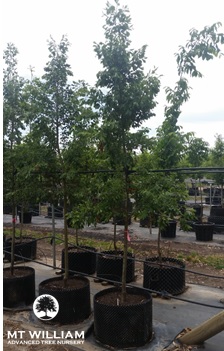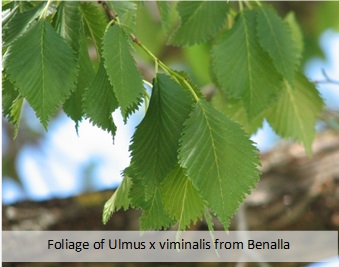
Elms and their significance in Australia.
Click here to download a printable PDF copy
The planting of Elms throughout Australia began early in the 1800’s by British settlers who had imported the various species from their homeland. Due to the rise of Dutch Elm Leaf Beetle and the untimely demise of elm species throughout Europe, Australia’s mature elms that can be found in parks, public gardens, country townships and streets are now regarded as some of the most significant elms in the world. Particularly Dutch elms and English elms were widely planted and grown as street
trees and in park avenues (especially in Victoria) in the late 19th and early 20th century. As a result of this, many avenues still remain, aged between 60 – 140 years.
At Mt William Advanced Tree Nursery, we are currently growing some of these significant elms that have come from selected sources. See list below.
-
Ulmus hollandica ‘Purpurascens’- Wallan
-
Ulmus hollandica ‘Purpurascens’- Benalla
-
Ulmus hollandica ‘Purpurascens’- Pleasant Street, Ballarat
-
Ulmus x viminalis- Benalla botanical gardens
-
Ulmus x viminalis- Lydiard Street, Ballarat
-
Ulmus x procera – Finley Avenue, Camperdown
-
Ulmus procera – Cnr Barkly/Eastwood Street, Bakery Hill Ballarat
-
Ulmus procera – O’Shannasy Street, Sunbury
Ulmus x hollandica var; Dutch Elm
The Dutch elm is usually a tree to 20m tall. With the name alluding to the country of origin, the tree and most of its clones have had the name applied in Australia. The Ulmus x hollandica ‘Purpurascens’ is one such clone and there are some keys to identifying the difference. The Young leaves, shoots and fruits of Ulmus x hollandica ‘Purpurascens’ (Purple leaved Dutch elm), are purplish; many of the leaves fold upwards.
Ulmus x hollandica ‘Purpurascens’ (Wallan)
Located between Queen street and Watson street in Wallan is an Avenue of honour that was planted in the early 1920’s to commemorate Wallan’s soldiers. 53 trees were originally planted to represent the number of soldiers from Wallan who had fought in WW1. The inscription on the plaque reads; ‘Memorial Avenue. This stand of elm trees was planted in memory of Wallan residents who served in the Australian Imperial Force in the Great War 1914 – 1918. Lest We Forget’.
Above image courtesy of Google Maps
This avenue of honour is particularly interesting as it is the only known major avenue planting of Ulmus x hollandica ‘Purpurascens’ across Victoria and possibly Australia. There are isolated plantings in St Kilda Rd, Gisborne and the Kyneton botanical gardens with a fair few planted in Benalla in the botanical gardens and surrounds.
A deciduous tree, the Ulmus x hollandica
‘Purpurascens’ has an upright slightly spreading form. The trees depicted at Wallan have been pollarded to encourage growth at the top. While they are known as purple leaved Dutch Elms, the purple colouring is not as distinct as the specimens found in Ballarat.
See the National Trust Listing Here.
Ulmus x hollandica ‘Purpurascens’ (Benalla)
As previously mentioned, the Benalla botanical gardens host specimens of Ulmus x hollandica ‘Purpurascens’ which Mt William Advanced Tree Nursery have collected budwood from. The gardens boast a beautiful avenue of alternating Dutch Elms (Ulmus x hollandica), purple-leaved Dutch Elms (Ulmus x hollandica ‘Purpurascens’) and English elms (Ulmus procera) that surround the oval.
Ulmus x hollandica ‘Purpurascens’ (Pleasant Street, Ballarat)
Not widely known, is another variety of the Ulmus x hollandica ‘Purpurascens’ that resides at Pleasant Street Ballarat. With much darker foliage, the Purple Leaved Dutch Elms on Pleasant Street are far easier to identify than those at Wallan and Benalla. This can easily be noticed in the below images.

The below ‘side by side’ analysis shows the differences between the 3 variations identified as purple leaved Dutch Elm. From left to right we can see how the prevalent the purple foliage becomes. The Wallan Elm has the least recognizable purple foliage while the Benalla has slightly more. The budwood used from Ballarat to grow the Purple Leaved Dutch Elm is by far the darkest of the three.
The leaf shape of Ulmus x hollandica ‘Purpurascens’ varies quite significantly from the specimens at Wallan and Benalla. Less ‘hairy’, the foliage is also more deeply serrated.
Ulmus x viminalis (Benalla)
Ulmus x viminalis is a natural hybrid tree that is extremely rare and can virtually only be found in some arboretums and avenue plantings. Once thought to be a variety of English elm, the Ulmus x viminalis was identified and observed as a hybrid by Ronald Melville in 1940. Being one of the only known occurrences of Ulmus x viminalis (Aside from the below listing), the trees have been listed on the significant trees register of Victoria (See below). The trees at Benalla are estimated to be 80 years of age.
Both images courtesy of Victorian Heritage Database.
See the National Trust Listing Here.
Ulmus x viminalis (Lydiard Street, Ballarat North)
Little is known about the occurrence of Ulmus x viminalis in Ballarat, but after budwood was sampled and grown on at Mt William Advanced Tree Nursery, the similarities between those identified at Benalla and Ballarat were virtually indistinguishable. Being known as the Twiggy Field Elm,
the leaves are sharply serrated and easily to identify.
Identification is usually based largely on the characteristics of foliage (Leaf Shape, Colour). Variation will occur in the habit of the tree and bark texture. As per Roger Spencer’s publication of Horticultural Flora of South-Eastern Australia Vol. 2, typically ‘Leaves chosen for identification should be typical ones taken, if possible, from the crown. Care should be taken to avoid the frequently atypical leaves that appear on young, lower, sucker and epicormic shoots.’
The tree that budwood was taken from in Lydiard street is pictured below.
Image above right courtesy of Google Maps, Image below courtesy of Melburnian Wiki User.
The image of foliage taken from Ulmus x viminalis in Benalla botanical gardens (image above) shows extreme similarity to those grown at Mt William Advanced Tree Nursery, (photographs above) which was sampled from Lydiard Street, Ballarat. A rounded, open, broad-crowned tree to about10m tall. – Horticultural Flora Vol. 2
Ulmus procera; English Elm
English elms are generally a more compact but densely branching tree growing to a maximum height of 30m in natural areas. Ulmus procera has not been as widely utilised as the Ulmus x hollandica in Australia. The habit that is typically displayed by Elms in Europe is not found on elms growing in South Eastern Australia. Here, the form is much more rounded. From seed, this species is highly variable when cultivated both in leaf characteristics and growth habit. The seedling variation in English elms in Australia also supports a theory that the English Elm is a clone of the Dutch Elm. R. Melville’s studies claimed that many of the trees cultivated in Melbourne are probably hybrids between Ulmus procera and Ulmus minor (Silver Elm).
Ulmus procera (Finlay Avenue, Camperdown)
The Finlay Avenue of Elms is a War Memorial Avenue in Camperdown located on Manifold Street. These Ulmus procera were planted in 1876 when Alexander Struthers Finlay and his son Colin donated 290 trees to the Town of Camperdown, and these plantings were referred to as the 'Finlay Avenue' in honour of the gift to the town (ref; Corangamite Shire Council Website). These trees are currently listed with the National Trust of Australia for cultural significance. Trees have been pollarded and are treasured by the township and visitors due to the trees’ contribution to the landscape. Corangamite Shire council currently has a management plan in place for the avenue which includes planting trials.
See the National Trust Listing Here.
Image above from Corangamite Shire Council Website.
Ulmus procera (Cnr Barkly/Eastwood st, Bakery Hill, Ballarat)
The Ulmus procera located at the corner roundabout of Barkley and Eastwood Street in Ballarat, although not included on the National trusts trees of significance register, are very impressive specimens.

Image above courtesy of Google Maps
References
Cassell’s Trees of Britain and Northern Europe © In the paintings, David More and Domino Books Ltd 2003 – © In the text, John White and Domino Books Ltd 2003 – David More and John White
Avenue of Honour Replacement Program
http://www.avenuesofhonour.org/
Horticulture Flora of South-Eastern Australia Vol. 2 © Royal Botanic Gardens Melbourne 1997 – Roger Spencer
Corangamite Shire Council
http://www.corangamite.vic.gov.au/
National Trust and Victorian Heritage Database Listings
Ulmus x viminalis (Benalla)
http://vhd.heritagecouncil.vic.gov.au/places/70863
Ulmus x hollandica Purpurascens (Wallan)
http://www.trusttrees.org.au/tree/VIC/Wallan/Northern_Highway

















